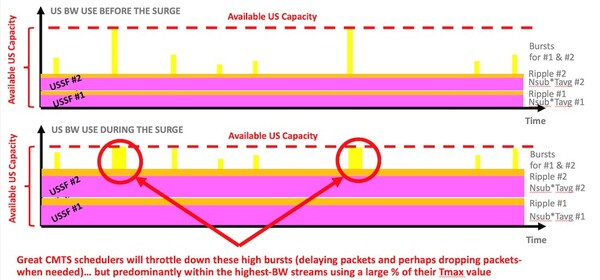 The current pandemic is giving us all an unprecedented glimpse into the future of network bandwidth demand.
The current pandemic is giving us all an unprecedented glimpse into the future of network bandwidth demand.
In our conversations with customers and through our devices in the field, we’ve seen two key trends emerge from the past few weeks when the world has been sheltering in place:
- Heavy network usage, which used to spike between 8pm-12am (4 hours) now occurs from 8am-2am (18 hours).
- Downstream traffic has increased by 26-86% in the daytime and by 12-32% at night. Meanwhile, upstream traffic has increased by 30-150% during the day and by 14-50% at night.
In other words, bandwidth is not only spiking; it’s spiking over much longer periods of time. And for the upstream, those spikes are much higher than they used to be.
CLICK TO TWEET: CommScope’s Tom Cloonan explains how service providers can manage the COVID-19 bandwidth surge in the near and long term.
First, the good news: We’ve seen minimal impact to quality of experience for the vast majority of subscribers. That’s due in large part to the forward-looking design of modern networks. For example, we built in plenty of headroom to absorb downstream SLA bursts, and this is now being used for both bandwidth bursts and quiescent operating levels. The cable modem termination system (CMTS) scheduling algorithms are doing a very good job spreading out bandwidth use over time.
Effectively, these measures are helping us flatten the BW curve whenever short bursts do occur.
But now, the bad news (rather, the opportunity): Subscribers are rapidly hitting data caps, download and upload times are increasing, and packet delays and drops are interrupting some experiences. This is a taste of what’s to come in the future if we (as an industry) do not begin to upgrade and expand the capacities on our networks.
The takeaway for cable operators is clear: In the short-term, maximizing current capacity can go a long way towards serving the immediate demands of consumers, but the only long-term solution is to increase available capacity per subscriber in both the downstream and upstream.
Luckily, for cable operators, there is a clear path to achieving future-ready capacity while meeting the extraordinary demands of our current situation.
The following is a checklist of short-term, mid-term, and long-term solutions for cable operators of all sizes to make the transition from managing today’s massive influx of pandemic-induced traffic to delivering the 10G speeds of the future.
Short-Term Solutions
The fixes outlined below show some examples of ways to maximize the current infrastructure and will likely provide between 5-66% improvement in bandwidth capacity. For example, transitioning upstream spectrum from 64-QAM Advanced Time Division Multiple Access (ATDMA) to 1024-QAM orthogonal frequency-division multiple access (OFDMA) would represent a 66% capacity increase.
- CMTS Configuration Changes
- Add additional DOCSIS channels
- RF Changes
- Perform Virtual Node Segmentation (This provides for double the upstream bandwidth)
- This is the single biggest change to rapidly increase significant bandwidth
- Cable Modem (CM) Changes
- Add additional DOCSIS 3.1 CMs utilizing OFDMA spectrum to leverage higher spectral efficiencies
- Perform Virtual Node Segmentation (This provides for double the upstream bandwidth)
Mid-Term Solutions
The solutions below focus primarily on making larger-scale plant and CMTS configuration changes as well as investing in building network capacity. While these revolve around more complex strategies for network upgrade, they have the potential to more broadly increase capacity and strengthen the network.
- Plant Clean-up Changes
- Convert Single Carrier-QAM (SC-QAM) channels, e.g. 32-QAM to 64-QAM operation
- Upstream and Downstream Investments
- Perform Physical Node-Splits
Long-Term Solutions
The following solutions are examples of some larger investments in network infrastructure that will set the stage for next-generation networks and ensure superior capacity well into the future. While they are also the most costly and complex solutions to implement, they represent the evolutionary step forward for operator networks.
- Long-Term Upstream & Downstream Proposals
- Perform 85MHz Mid-Splits (helps with Average and Burst BW growth)
- Perform 204MHz High-Splits (helps with Average and Burst BW growth)
- Longer-Term Proposals (DOCSIS 4.0, 10G Initiative)
- Add Ultra-High-Splits or Full Duplex DOCSIS FDX (helps with Average and Burst BW growth in the US)
- Add Extended Spectrum DOCSIS (helps with Average and Burst BW growth in the DS)
We are living in unprecedented times, but they also represent an unprecedented opportunity to see ahead and plan tomorrow’s networks.















